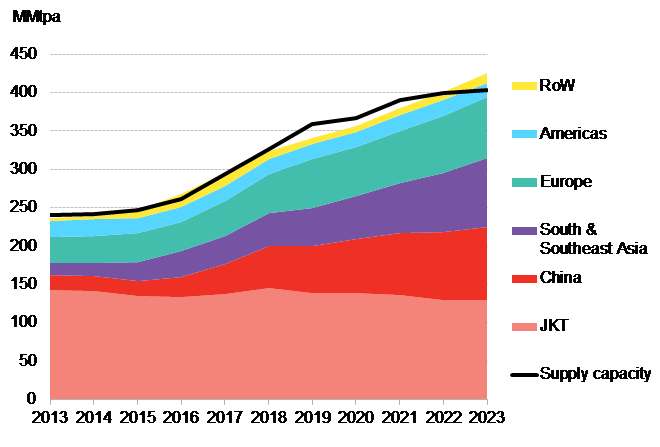The liquefied natural gas (LNG) market is set to see shifts between excess supply and excess demand during 2019-2023.
LNG exports and imports rose 10 percent in 2018. Growth rates of LNG exports and imports are seen moving out of sync in 2019-2023. LNG exports are increasing faster than imports in 2019 – and then imports outstripping exports in 2022-2023.
LNG supply will be growing by 33 million metric tons per year in 2019, reaching a record 358MMtpa, with the U.S. Gulf Coast, Australia and Russia commissioning or expanding export facilities, , according to a research firm BloombergNEF.
Meanwhile, structural LNG demand, or weather-neutral demand at current LNG prices, is expected to rise by 17MMtpa this year, thanks to additional purchases for power generation and heating in Europe and Asia.
“This year’s excess supply of 16MMtpa will be hard for the market to absorb, unless we get a dose of strong demand for either a hotter summer or colder winter in North Asia or Europe. If not, there will be pressure will be on LNG prices,” Ashish Sethia, head of commodities at BNEF, said.
A seven multibillion-dollar LNG export projects, including three in Louisiana in the U.S. and two in Mozambique, are close to a final investment decision and are likely to put extra supply into world markets post-2023.
Maggie Kuang, head of LNG analysis at BNEF, said: “We expect the LNG market to become tight again from 2022 onwards, with demand rising due to higher penetration of gas in China’s inner provinces and growth of LNG bunkering in inland waterways, and as Thailand and Pakistan become important engines of LNG demand growth.”
Europe will become increasingly import-dependent for its gas over the next few years. “The LNG market is forecast to tighten by 2023, and European prices will need to be high enough to compete with those of fast-growing markets in Asia and to attract LNG imports,” John Twomey, head of European gas analysis at BNEF, said.
The increase in LNG demand, totalling nearly 30MMtpa, has resulted into 41 percent surge in purchasing of the commodity by China, and other significant percentage increases in imports in South Korea, India, Pakistan, and Europe.
Australia, Russia (two) and the U.S. (Three) started LNG liquefaction and export facilities in 2018. Qatar, the world’s largest LNG producer, increased the production of LNG marginally,
the BNEF report says.

